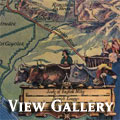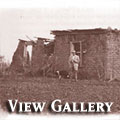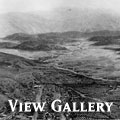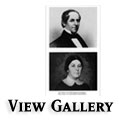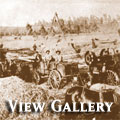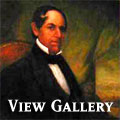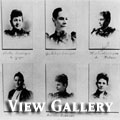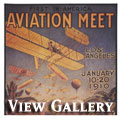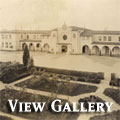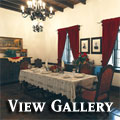History
-
Periods
- First Spanish Land Grant
- Juan Jose Dominguez Era
- Cristobal Dominguez Era
- Manuel Dominguez Era
- Mexican Independence
- Battle of Dominguez Hill
- United States Patent of Ownership
- Manuel’s Daughters Inherit the Rancho
- 1910 International Aviation Meet
- The Claretians
- The Dominguez Legacy Continues
First Spanish Land Grant
The Rancho San Pedro is the site of the First Spanish land grant in California. The land was granted in 1784 by King Carlos III to Juan Jose Dominguez, a retired Spanish soldier who came to California with the Portola expedition and later with Father Junipero Serra. The original land grant encompassed 75,000 acres, including the entire Los Angeles harbor. The land has passed through successive generations and remains in the Dominguez family. Today, the descendants operate the Watson Land Company and the Carson Estates Company on the original Rancho land.
Juan Jose Dominguez Era
Juan Jose Dominguez lived on the Rancho intermittently until his death in 1809. Juan Jose had prepared a will prior to his death, but that will did not specify to whom the Rancho land should pass. Being a bachelor and without children, the Rancho passed to Juan Jose’s only living relative, his nephew, Cristobal Dominguez. At the time of Juan Jose’s death, there had never been a survey of the Rancho lands, there was no map of the land grant, and all of the paperwork associated with the grant had been lost or destroyed.
Cristobal Dominguez Era
Cristobal Dominguez was also a soldier with the Spanish army, stationed at the Mission San Juan Capistrano. Cristobal was married with eight children, six of whom survived to adulthood. Because of the confusion created regarding the size and ownership of the Rancho upon Juan Jose’s death, in 1817 Cristobal requested the Spanish government to re-grant the Rancho land in his name. This caused the first survey of the land, which stretched from the Los Angeles River in the east to the Pacific Ocean. This sycamore tree, which still stands at the corner of Poppy and Short Streets in Compton, was used in the original survey to mark the northern boundary of the Rancho San Pedro. The survey and the re-grant of the land were completed in 1823, establishing Cristobal as the sole owner of the Rancho. While Cristobal never lived on the Rancho lands, the re-grant allowed him to pass the land on to his wife and children upon his death in 1825.
Manuel Dominguez Era
Crisobal’s eldest living son, Manuel Dominguez, was only 22 years old when, upon his father’s death, he, his mother and five siblings moved from the Mission San Juan Capistrano to Los Angeles. The family lived in the pueblo of Los Angeles while Manuel and his brothers constructed homes on the Rancho property. Manuel met Maria Engracia de Cota, a Spanish woman whose father was a local Commissioner for the Mexican government in Los Angeles. Manuel and Maria married in 1827.
Mexican Independence
At this time, California was changing from Spanish to Mexican control. All of the families who had received land grants under Spanish rule were required to present proof of land ownership to the Mexican government in order to keep their land. In 1826, the Dominguez family received confirmation that the Mexican government recognized the Spanish re-grant of the Rancho to Cristobal Dominguez and his heirs. This was very important, as many Rancheros lost all of their lands during this period due to poor record keeping and the lack of documentation declaring ownership of the land.
Manuel was the only one of his siblings who was able to read and write. His management of the Rancho lands brought him into contact with American traders and he became fluent in English. As a Spaniard who was a landowner, literate and spoke English, Manuel was a natural choice to become a leader in Los Angeles.
In 1828, Manuel was elected to the Los Angeles City Council. Four years later, at the age of 29, he was elected Mayor of Los Angeles. From 1833 to 1834, Manuel served as a representative from Los Angeles to the Mexican Provincial legislature in Monterey. At this same time, he was appointed by the Governor as the Third Prefect of the Southern District of California, which gave Manuel authority over all of Los Angeles and Orange Counties.
Battle of Dominguez Hill
In the following years, the United States and Mexico began to fight for control of California. One skirmish, the Battle of Dominguez Ranch, took place here at the Rancho. In 1848, the Treaty of Guadalupe-Hidalgo ended the Mexican-American War. Manuel was elected as one of seven delegates from Los Angeles to the First Constitutional Convention in California. At this convention, Manuel and the other 47 delegates from throughout California signed California’s State Constitution. In 1856, Manuel served on the Los Angeles County Board of Supervisors. Upon the end of his term, Manuel returned to private life on the Rancho. While he was solicited to run for Governor and offered various appointive offices, Manuel refused them all.
United States Patent of Ownership
During this time Manuel was also focused on acquiring a United States land patent, which would solidify ownership of the Rancho under United States’ law. The patent was granted and signed by President James Buchanan on December 18, 1858, more than 7 years after it was first requested and nearly 75 years after the original land grant. This was the first U.S. land patent granted in California. However, throughout the years of political turmoil in California, prolonged court battles over ownership of the Rancho, numerous surveys of the land, and the sale of some parcels, the United States land patent stated that the Rancho now encompassed 25,000 acres, far fewer than the 75,000 acres included in the original land grant.
Manuel’s Daughters Inherit the Rancho
Upon Manuel’s death in 1882, and the passing of his wife one year later, the Rancho lands were partitioned among his six surviving children, all daughters. Three of the married daughters continued the Dominguez legacy through the Carson, Del Amo and Watson families.
1910 International Aviation Meet
In 1910, Dr. Gregorio Del Amo, the husband of Susana Dominguez, arranged for the Rancho to become part of aviation history. In that year, the first International Aviation Meet was held at the Rancho. The Meet lasted for 10 days, with viewing stands erected just for the occasion. It provided the first opportunity for people on the West Coast to see an airplane in flight. Aviation pioneers such as William Boeing attended and were inspired to develop the aviation industry in Southern California.
The Claretians
Manuel and his family were also very devout Catholics. All of the daughters made major donations to the construction of St. Vibiana’s, the former Cathedral in downtown Los Angeles. In 1922, the two remaining daughters, Susana Del Amo and Reyes Dominguez, deeded seventeen acres adjacent to the family home to the Claretian Missionaries. In 1924, the Claretian Missionaries began using the adobe home as a graduate school for Claretians and later as a seminary. In recognition of this contribution to the Claretians, special arrangements were made to allow Susana and Gregorio Del Amo to be buried in a crypt beneath the altar of the chapel located in the modern day Claretian retirement home.
The Dominguez Legacy Continues
Throughout the history of the Rancho, the value of the land continued to increase. After the discovery of oil on the property in 1921, the value of the land skyrocketed. Manuel Dominguez was a firm believer in the value of the Rancho land. Throughout his life, he resisted selling the land, preferring instead to lease parcels and retain ownership. This strategy was followed by his children, which allowed for a major portion of the land grant to be held by family members today.
Without the foresight and leadership of Juan Jose, Cristobal and Manuel Dominguez, the Rancho San Pedro may not have survived to the modern day. Many of the Spanish land grants in California were sold to settlers, abandoned, or lost entirely due to costly court battles to defend ownership of the property. Recently, the Dominguez family has been host to the King and Queen of Spain, the Governors of California, and other dignitaries at events held throughout the Rancho lands. The family and the homestead are entwined in California’s rich Spanish, Mexican and American history.
The descendants of Manuel Dominguez continue to operate businesses on the extensive Rancho lands today.
The Dominguez Adobe is California Historical Landmark Number 152 and in 1976 was placed on the National Register of Historic Places by the United States Department of the Interior. The Rancho San Pedro and the Dominguez Adobe Museum are truly unique treasures in Los Angeles.


